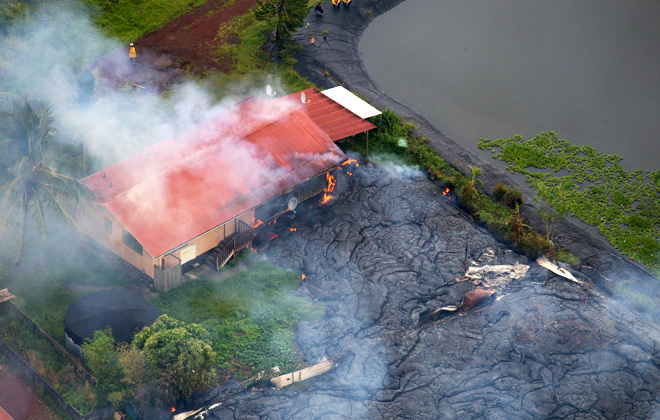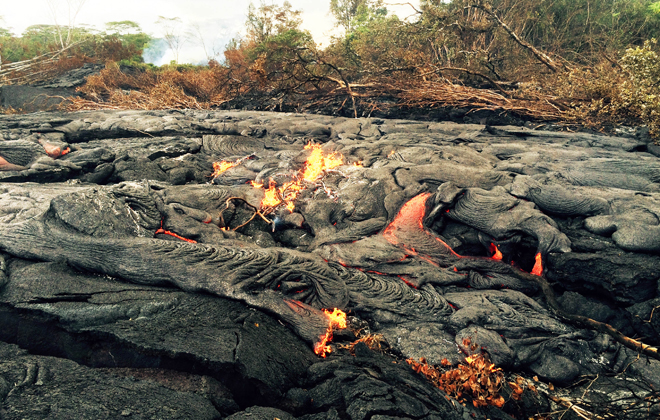Lava ignites first house in Pahoa

Pahoa, Hawaii: The flow from Kilauea consumes the first home in Pahoa. Located on Apa‘a Street, the red roofed home ignites from the heat of the lava as the flow slowly creeps up to it.

This Nov. 8, 2014 photo from the U.S. Geological Survey shows a breakout, or area where lava oozes to the side of a flow upslope of the stalled leading edge, about 400 meters (0.25 miles) upslope of Cemetery Road near the town of Pahoa on the Big Island of Hawaii. Hawaii County civil defense officials said in a statement Saturday the lava's front remains about 480 feet from Pahoa Village Road. This position hasn't changed since Oct. 30. But lava is creeping out at several spots upslope of the leading edge. (AP Photo/U.S. Geological Survey)


PAHOA >> Lava ignited its first house in Pahoa about noon Monday.
About an hour earlier, the lava was about 15 yards away from the Apaa Street house, but started moving more rapidly, officials said.
The house sat about 2 feet off the ground. The lava first moved underneath it before surrounding the woodblocks it was on, igniting the home shortly afterward.
The family who owns the home lives on the mainland, but a relative on Hawaii island was enroute and expected to arrive in time to watch it burn.
The front of the flow had passed the house but now a breakout behind the front reached the building.
Civil Defense said the flow was about half a mile from a neighboring home, and lava also burned a small garden shed on the property Monday morning.
Don't miss out on what's happening!
Stay in touch with breaking news, as it happens, conveniently in your email inbox. It's FREE!
Residents were told to expect to see smoke coming from the fire, and that Civil Defense would be providing updates for the community.
Civil Defense officials said Monday morning a finger of lava also moved to within 22 yards of the closed Pahoa refuse transfer station on Sunday. However, the front of the flow remained stalled about 480 feet from Pahoa Village Road.
Hawaiian Volcano Observatory geologists reported that a breakout lava flow crossed Apaa Road Sunday morning and separated into three lobes.
One lobe is approaching the fence of the transfer station, another lobe is heading toward abandoned buildings across the street from the transfer station and a third lobe is moving along the margin of the existing lava flow and was approaching a power pole.
The lava was moving at a rate of 3 to 5 yards an hour.
Imelda Raras, who lives on the other end of Apaa Street from where the house that has been ignited, said the homeowner moved his horses and other animals to another location weeks ago.
Raras and her family have put a lot of their belongings in storage and prepared to go to a friend’s home if the lava gets close.
"It’s slow," she said. "Maybe there will come a time when it will be faster again."
When lava reaches a structure, firefighters will let it burn but fight any fires that spread or threaten other structures, Hawaii County Civil Defense Director Darryl Oliveira said.
Officials were planning to allow homeowners to make arrangements to watch their homes burn down as a means of closure and to document the destruction for insurance purposes, Oliveira said.
On Monday, about 400 students whose school is in the projected path of the lava flow, started classes in portables set up in the parking lot of Keaau High School. The newly created Keonepoko North School replaces Keonepoko Elementary School in Hawaiian Beaches.
Another 450 students at other Pahoa-area schools also started classes in Keaau Monday.
Donalyn Dela Cruz, a spokeswoman for the Department of Education, said the transition went smoothly Monday.
"Parents expressed relief and were pleased with the arrangements of the classrooms," Dela Cruz said in an e-mail. "Many high school students were helpful with the younger students."
Schools in the area were closed last month to prepare for the transfer of about 1,700 students and 300 employees to other schools on their side of the lava’s projected path.
On Friday, classes resumed at Pahoa High School with hundreds of new students who had been attending Keaau High School.
Over the weekend, volcano scientists released photos of lava on Apaa Road that showed how the flow has been inflating since the front stalled.
The contrasting photos show lava crossing Apaa Road on Oct. 25 and the lava on the road on Nov. 4. When the lava first crossed the road, it was 3 feet thick. But 10 days later, on Nov. 4, the lava was 12 feet thick. A power pole, surrounded by lava in the photos, gives some perspective on the inflation and how high the lava has risen.
Star-Advertiser reporter Craig Gima and The Associated Press contributed to this story.



